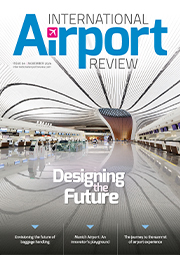Using artificial intelligence to mitigate cyber-risks
- Like
- Digg
- Del
- Tumblr
- VKontakte
- Buffer
- Love This
- Odnoklassniki
- Meneame
- Blogger
- Amazon
- Yahoo Mail
- Gmail
- AOL
- Newsvine
- HackerNews
- Evernote
- MySpace
- Mail.ru
- Viadeo
- Line
- Comments
- Yummly
- SMS
- Viber
- Telegram
- Subscribe
- Skype
- Facebook Messenger
- Kakao
- LiveJournal
- Yammer
- Edgar
- Fintel
- Mix
- Instapaper
- Copy Link
Posted: 21 June 2019 | Brad Hayes - Circadence Corporation, Kristina Dores - Namibia Civil Aviation Authority | No comments yet
Artificial intelligence, alongside proper training and education, can manage even the worst of security breaches into a positive outcome for airports and their users, says Kristina Dores, Chief, Aerodromes & Ground Aids at Namibia Civil Aviation Authority, and Brad Hayes, CTO at Circadence Corporation. However, the key question is when (not if) will organisations take the steps to prepare for the coming wave of digitisation?


Highly-interconnected and increasingly-digitised systems are a necessary part of modern airport infrastructure. However, alongside the need for greater data-sharing, both within and across airports, this results in an increase in cyber-threats. Furthermore, vulnerabilities at these interfaces – through personnel and digital systems alike – lead to an increased threat of intrusion and potentially catastrophic disruption.
This problem is not one that we can simply train and hire our way out of as these systems and their attack surfaces do not scale linearly in complexity. Not only can artificial intelligence (AI) be utilised to mitigate these risks while enabling better situational awareness, threat detection and response at scale, but it may quickly become the best economical solution.
The challenge
To maintain situational awareness within an airport, there is generally a requirement to fuse information from multiple data sources. Suspicious behaviours are most often characterised by a series of actions rather than a single observation. Without tighter integration, a system might not find anything anomalous about someone trying to buy a last-minute ticket and being turned away. This same situation could be interpreted very differently if from every ticket counter staff were sharing information within the airport environment, enabling recognition that the same person might be attempting to buy last-minute tickets at multiple counters – a far more suspicious behaviour. Understandably, airline ticketing data sources operating with proprietary formats on proprietary systems aren’t shared even at a local level. Facilitating the connection of these data sources would logically lead to increased situational awareness; empowering security and other personnel to make more informed decisions. Legalities aside, the cost of this facilitation could pose greater risk to the system itself. Each interface between systems, with every individual granted access, would increase the potential attack surface, providing new endpoints for potential compromise.
The rest of this article is restricted - login or subscribe free to access


Why subscribe? Join our growing community of thousands of industry professionals and gain access to:
- bi-monthly issues in print and/or digital format
- case studies, whitepapers, webinars and industry-leading content
- breaking news and features
- our extensive online archive of thousands of articles and years of past issues
- ...And it's all free!
Click here to Subscribe today Login here
Issue
Related topics
Autonomous Technology, Big data, Cyber-security, Information technology (IT), New technologies, Safety, Security


















